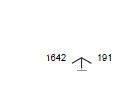callum112233
Member
I've been wondering, how do you read gradients when they are written down like this?



However how many are actually accurate?
To me they are just an indication of a steep bit or not so steep bit.
They really only refer to the average grade on that section of line not the real gradient to be found when surveying. (I have found a short section of 1 - 20 within a 1 - 49 marked grade)
Not just me either as can be seen if you read the foreword to the NERAs publication on North Eastern Railway gradient sections.
They are only as accurate as when they were applied, which is normally during construction of the original line.However how many are actually accurate?
To me they are just an indication of a steep bit or not so steep bit.
They really only refer to the average grade on that section of line not the real gradient to be found when surveying. (I have found a short section of 1 - 20 within a 1 - 49 marked grade)
Not just me either as can be seen if you read the foreword to the NERAs publication on North Eastern Railway gradient sections.
Gradients are required to design a Temporary Speed Restriction.
